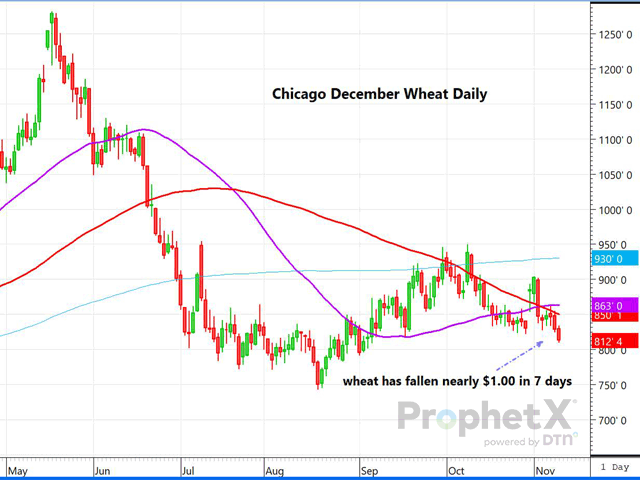USDA Reports Review
Ho-Hum November USDA Reports Lead to Little Market Reaction for Corn and Soybeans
The November USDA reports featured only modest yield, production and ending stocks revisions for corn and soybeans. The market was not excited by the news and didn't change much from pre-report to post-report. Wheat, which was little affected by the report, continued its recent bearish trade.
CORN
Corn futures, trading maybe 4 to 5 cents lower prior to the report, likely got a bit of a boost from the lower-than-expected increase in ending stocks. There were few major changes expected for corn, but the increase of 0.4 bushel per acre (bpa), to 172.3 bpa -- and the production increase of 35 million bushels (mb) to 13.930 billion bushels (bb) -- was more than expected, but nearly offset by a 25 mb rise in feed and residual. That sent corn ending stocks to 1.182 bb, up just 10 mb, and 30 mb lower than what Dow Jones' average pre-report estimates had expected. What was perhaps the biggest surprise of the report was the failure to reduce the U.S. corn export forecast. Traders had anticipated a minimum reduction of 50 mb considering the current corn export pace is down 53% from a year ago and the fact that the U.S. is severely overpriced relative to both Ukraine and Brazil. Typically, if we see an increase of September to November yields, it is likely to see a further increase in the final numbers. Illinois scored a record yield of 215 bpa, up 5 bpa from October, with both Indiana and Iowa up 4 bpa and 2 bpa, respectively.
On the global front, there were just minor changes too. South Africa's corn production was lowered by 600,000 metric tons (23.6 mb) from 17.3 million metric tons (mmt) to 16.7 mmt (657 mb). The European Union corn crop was lowered again, from 56.2 mmt to 54.8 mmt (2.16 bb), as drought affected that crop more than earlier thought. World ending stocks on corn for 2022-23 fell slightly, from 301.2 mmt to 300.76 mmt (11.8 bb) -- an insignificant, but slightly constructive change. Corn had been trading down 4 cents prior to the report and, by Wednesday's close, was down 3 cents.
P[L1] D[0x0] M[300x250] OOP[F] ADUNIT[] T[]
SOYBEANS:
As in corn, USDA raised yield, production and ending stocks for soybeans. Yield came in at a better-than-expected 50.2 bpa, with production up 33 mb from October, with a crop of 4.35 bb, and with harvested acres left the same. U.S. soy ending stocks rose by 20 mb, about 5 mb more than the traders had anticipated, as U.S. crush demand was increased by 10 mb to 2.245 bb to account for the record-large crush margins that we have seen. Ending stocks were estimated at 220 mb compared to 200 mb last month. On the domestic side, the report was considered slightly bearish for beans. The soybean season average price was left unchanged at $14 per bushel, while the soymeal average price was increased by $10 per short ton, to $400 per short ton. Bean oil was left untouched, at 69 cents per pound.
There were only minor changes on the world front. Argentine soybean production was dropped 1.5 mmt to 49.5 mmt (1.82 bb) due to the ongoing drought. However, Brazil soy production was left unchanged at a record 152 mmt (5.58 bb), even though, on Wednesday, Brazil's supply company, CONAB, had raised the same crop to a record-large 153.5 mmt (5.64 bb) on great early weather and a quick planting pace. China soybean imports were left at 98 mmt (3.6 bb), despite the poor crush margins and constant lockdowns, and the ongoing import pace, which is down 7.4% from last year. World ending stocks on soybeans moved up to 102.17 mmt (3.75 bb) from 100.52 mmt, considered slightly bearish. Soybean futures, trading up 6 cents prior to the report, finished up 5 1/2 cents.
WHEAT
Wheat changes in the U.S. were even less exciting than corn or beans, but it was the wheat market that moved the most after the report. With food use increased by 7 mb and seed use decreased by 2 mb, the 5 mb net demand increase translated directly to ending stocks, putting them at 571 mb -- the lowest since 2007-08, and about 6 mb below the average Dow Jones pre-report estimate. There were only minor changes in by-class stocks of wheat, with hard red stocks falling 6 mb and hard red spring rising by the same amount. Both soft red and white winter wheat declined by 4 mb from October, with durum stocks up 4 mb. U.S. wheat exports were left unchanged, and the season average price was left unchanged at $9.20 per bushel.
On the world front, Russian wheat production was left unchanged, at 91 mmt (3.34 bb), despite several private analysts suggesting that it might be closer to 100 mmt (3.67 bb). Argentina's crop, affected by the ongoing drought, was slashed 2 mmt to 15.5 mmt (570 mb). That is still high compared to the Argentine exchanges, which see that falling closer to 13 mmt (478 mb). Australia's crop was increased by 1.5 mmt to 34.5 mmt (1.27 bb), with exports rising 1 mmt to 26 mmt (955 mb). Argentina's wheat exports were reduced by 2 mmt to 10 mmt (367 mb). The net effect was that world ending stocks of wheat were raised slightly to 267.82 mmt (9.84 bb), compared to 267.5 mmt in October.
Dana Mantini can be reached at dana.mantini@dtn.com
Follow Dana Mantini on Twitter @mantini_r
(c) Copyright 2022 DTN, LLC. All rights reserved.




